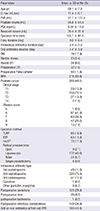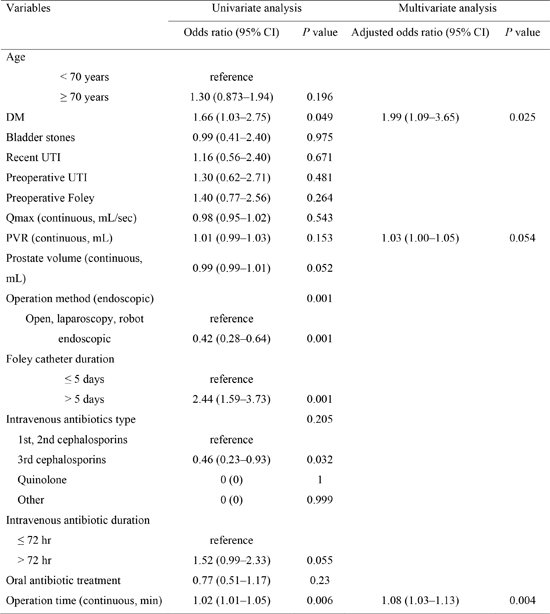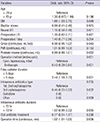1. Bjerklund Johansen TE, Cek M, Naber K, Stratchounski L, Svendsen MV, Tenke P. PEP and PEAP study investigators. European Society of Infections in Urology. Prevalence of hospital-acquired urinary tract infections in urology departments. Eur Urol. 2007; 51:1100–1111.
2. Chodak GW, Plaut ME. Systemic antibiotics for prophylaxis in urologic surgery: a critical review. J Urol. 1979; 121:695–699.
3. Grabe M. Controversies in antibiotic prophylaxis in urology. Int J Antimicrob Agents. 2004; 23:S17–S23.
4. Grabe M, Botto H, Cek M, Tenke P, Wagenlehner FM, Naber KG, Bjerklund Johansen TE. Preoperative assessment of the patient and risk factors for infectious complications and tentative classification of surgical field contamination of urological procedures. World J Urol. 2012; 30:39–50.
5. Mangram AJ, Horan TC, Pearson ML, Silver LC, Jarvis WR. Guideline for prevention of surgical site infection, 1999: Hospital Infection Control Practices Advisory Committee. Infect Control Hosp Epidemiol. 1999; 20:250–278.
6. Vivien A, Lazard T, Rauss A, Laisné MJ, Bonnet F. Infection after transurethral resection of the prostate: variation among centers and correlation with a long-lasting surgical procedure: association pour la Recherche en Anesthésie-Réanimation. Eur Urol. 1998; 33:365–369.
7. Colau A, Lucet JC, Rufat P, Botto H, Benoit G, Jardin A. Incidence and risk factors of bacteriuria after transurethral resection of the prostate. Eur Urol. 2001; 39:272–276.
8. Girou E, Rioux C, Brun-Buisson C, Lobel B. Infection Committee of the French Association of Urology. The postoperative bacteriuria score: a new way to predict nosocomial infection after prostate surgery. Infect Control Hosp Epidemiol. 2006; 27:847–854.
9. Huang X, Shi HB, Wang XH, Zhang XJ, Chen B, Men XW, Yu ZY. Bacteriuria after bipolar transurethral resection of the prostate: risk factors and correlation with leukocyturia. Urology. 2011; 77:1183–1187.
10. Terai A, Ichioka K, Kohei N, Ueda N, Utsunomiya N, Inoue K. Antibiotic prophylaxis in radical prostatectomy: 1-day versus 4-day treatments. Int J Urol. 2006; 13:1488–1493.
11. Takeyama K, Takahashi S, Maeda T, Mutoh M, Kunishima Y, Matsukawa M, Takagi Y. Comparison of 1-day, 2-day, and 3-day administration of antimicrobial prophylaxis in radical prostatectomy. J Infect Chemother. 2007; 13:320–323.
12. Sakura M, Kawakami S, Yoshida S, Masuda H, Kobayashi T, Kihara K. Prospective comparative study of single dose versus 3-day administration of antimicrobial prophylaxis in minimum incision endoscopic radical prostatectomy. Int J Urol. 2008; 15:328–331.
13. Stranne J, Aus G, Hansson C, Lodding P, Pileblad E, Hugosson J. Single-dose orally administered quinolone appears to be sufficient antibiotic prophylaxis for radical retropubic prostatectomy. Scand J Urol Nephrol. 2004; 38:143–147.
14. The Korean Society of Infectious Diseases. The Korean Society for Chemotherapy. Korean Association of Urogenital Tract Infection and Inflammation. The Korean Society of Clinical Microbiology. Clinical guideline for the diagnosis and treatment of urinary tract infections: asymptomatic bacteriuria, uncomplicated & complicated urinary tract infections, bacterial prostatitis. Infect Chemother. 2011; 43:1–25.
15. Culver DH, Horan TC, Gaynes RP, Martone WJ, Jarvis WR, Emori TG, Banerjee SN, Edwards JR, Tolson JS, Henderson TS, et al. Surgical wound infection rates by wound class, operative procedure, and patient risk index. National Nosocomial Infections Surveillance System. Am J Med. 1991; 91:152S–157S.
16. Wagenlehner FM, Wagenlehner C, Schinzel S, Naber KG. Working Group "Urological Infections" of German Society of Urology. Prospective, randomized, multicentric, open, comparative study on the efficacy of a prophylactic single dose of 500 mg levofloxacin versus 1920 mg trimethoprim/sulfamethoxazole versus a control group in patients undergoing TUR of the prostate. Eur Urol. 2005; 47:549–556.
17. Madsen PO, Larsen EH, Dørflinger T. The role of antibacterial prophylaxis in urologic surgery. Urology. 1985; 26:38–42.
18. Berry A, Barratt A. Prophylactic antibiotic use in transurethral prostatic resection: a meta-analysis. J Urol. 2002; 167:571–577.
19. Qiang W, Jianchen W, MacDonald R, Monga M, Wilt TJ. Antibiotic prophylaxis for transurethral prostatic resection in men with preoperative urine containing less than 100,000 bacteria per ml: a systematic review. J Urol. 2005; 173:1175–1181.
20. Rassweiler J, Seemann O, Schulze M, Teber D, Hatzinger M, Frede T. Laparoscopic versus open radical prostatectomy: a comparative study at a single institution. J Urol. 2003; 169:1689–1693.
21. Matsumoto T, Kiyota H, Matsukawa M, Yasuda M, Arakawa S, Monden K. Japanese Society of UTI Cooperative Study Group (Chairman; Tetsuro Matsumoto). Japanese guidelines for prevention of perioperative infections in urological field. Int J Urol. 2007; 14:890–909.
22. Merle V, Germain JM, Bugel H, Nouvellon M, Lemeland JF, Czernichow P, Grise P. Nosocomial urinary tract infections in urologic patients: assessment of a prospective surveillance program including 10,000 patients. Eur Urol. 2002; 41:483–489.
23. May M, Brookman-Amissah S, Hoschke B, Gilfrich C, Braun KP, Kendel F. Post-void residual urine as a predictor of urinary tract infection: is there a cutoff value in asymptomatic men? J Urol. 2009; 181:2540–2544.
24. Hwang EC, Yu SH, Kim JB, Jung SI, Kang TW, Kwon DD, Park K. Risk factors of infectious complications after transurethral prostate surgery in patients with preoperative sterile urine. Korean J Urogenit Tract Infect Inflamm. 2013; 8:27–31.
25. Viitanen J, Talja M, Jussila E, Nurmi M, Permi J, Puolakka VM, Rintala E, Salmela H, Tiitinen J, Tuhkanen K, et al. Randomized controlled study of chemoprophylaxis in transurethral prostatectomy. J Urol. 1993; 150:1715–1717.
26. Ambiru S, Kato A, Kimura F, Shimizu H, Yoshidome H, Otsuka M, Miyazaki M. Poor postoperative blood glucose control increases surgical site infections after surgery for hepato-biliary-pancreatic cancer: a prospective study in a high-volume institute in Japan. J Hosp Infect. 2008; 68:230–233.
27. Shilling AM, Raphael J. Diabetes, hyperglycemia, and infections. Best Pract Res Clin Anaesthesiol. 2008; 22:519–535.
28. Geerlings SE. Urinary tract infections in patients with diabetes mellitus: epidemiology, pathogenesis and treatment. Int J Antimicrob Agents. 2008; 31:S54–S57.
29. Bootsma AM, Laguna Pes MP, Geerlings SE, Goossens A. Antibiotic prophylaxis in urologic procedures: a systematic review. Eur Urol. 2008; 54:1270–1286.
30. Wolf JS Jr, Bennett CJ, Dmochowski RR, Hollenbeck BK, Pearle MS, Schaeffer AJ. Urologic Surgery Antimicrobial Prophylaxis Best Practice Policy Panel. Best practice policy statement on urologic surgery antimicrobial prophylaxis. J Urol. 2008; 179:1379–1390.





 PDF
PDF ePub
ePub Citation
Citation Print
Print







 XML Download
XML Download